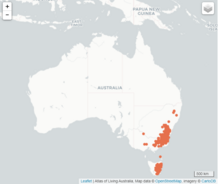
Freycinet National Park is a national park on the east coast of Tasmania, Australia, 125 kilometres (78 mi) northeast of Hobart. It occupies a large part of the Freycinet Peninsula, named after French navigator Louis de Freycinet, and Schouten Island. Founded in 1916, it is Tasmania's oldest park, along with Mount Field National Park. Bordering the national park is the small settlement of Coles Bay, and the largest nearby town is Swansea. Freycinet contains part of the rugged Tasmanian coastline and includes the secluded Wineglass Bay. Features of the park include its red and pink granite formations and a series of jagged granite peaks in a line, called "The Hazards".

The Threatened Species Protection Act 1995, is an act of the Parliament of Tasmania that provides the statute relating to conservation of flora and fauna. Its long title is An Act to provide for the protection and management of threatened native flora and fauna and to enable and promote the conservation of native flora and fauna. It received the royal assent on 14 November 1995.

Callitris oblonga, also known as the South Esk pine, pygmy cypress pine, pigmy cypress pine, river pine, or Tasmanian cypress pine, is a species of conifer in the family Cupressaceae. It is endemic to Australia, where it is native to New South Wales and Tasmania, with one subspecies introduced in Victoria. It is considered vulnerable and faces a number of threats including land clearing, habitat degradation, and damage from or competition with invasive species.

Land clearing in Australia describes the removal of native vegetation and deforestation in Australia. Land clearing involves the removal of native vegetation and habitats, including the bulldozing of native bushlands, forests, savannah, woodlands and native grasslands and the draining of natural wetlands for replacement with agriculture, urban and other land uses.
Scottsdale Reserve is a 1,328-hectare (3,280-acre) nature reserve on the Murrumbidgee River in south-central New South Wales, Australia. It is 79 kilometres (49 mi) south of Canberra, and 4 kilometres (2.5 mi) north of Bredbo. It is owned and managed by Bush Heritage Australia (BHA), which purchased it in 2006. The purchase was supportive of projects aiming to connect existing fragmented remnant habitat such as K2C. Since the 1870s up until 2006, the land was used for agriculture – primarily sheep grazing with some minor cropping. A significant component of the Reserve has been cleared of native vegetation.

Scleranthus, the knawels, are a genus of herbaceous plants in the family Caryophyllaceae. It includes 12 species native to Europe, Siberia, western Asia, north Africa, Ethiopia, New Guinea, and Australia.

Gymnoschoenus sphaerocephalus, commonly known as buttongrass, is a species of tussock-forming sedge from southeastern Australia. It forms part of a unique habitat in Tasmania.

Gahnia grandis is a tussock-forming perennial plant found in southeastern mainland Australia and Tasmania.

The biodiversity of Tasmania is of exceptional biological and paleoecological interest. A state of Australia, it is a large South Pacific archipelago of one large main island and a range of smaller islands. The terrain includes a variety of reefs, atolls, many small islands, and a variety of topographical and edaphic regions on the largest island, all of which promote the development of unusually concentrated biodiversity. During long periods geographically and genetically isolated, it is known for its unique flora and fauna. The region's climate is oceanic.
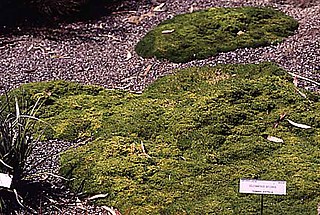
Scleranthus biflorus is a cushion-bush found in Australia and New Zealand. Other common names include the knawel and two-flowered knawel or twin-flower knawel.

Agastachys odorata, commonly known as the white waratah or fragrant candlebush, is the sole member of the genus Agastachys in the protea family. It is an evergreen shrub to small tree and is endemic to the heaths and buttongrass sedgelands of western Tasmania.

Poa labillardierei, also known as common tussock-grass, is a species of tussock grass that is endemic to Australia. It is found in southern and eastern Australia, including Tasmania. There are differing variations, Poa labillardierei var. acrisVickery and Poa labillardierei var. labillardierei.
The Queanbeyan Nature Reserve is a protected nature reserve that is located in the Southern Tablelands region of New South Wales, in eastern Australia. The 67-hectare (170-acre) reserve is situated approximately 4 kilometres (2.5 mi) west-south-west of the City of Queanbeyan.

Carex archeri, known as Archer's sedge, is a species of sedge in the genus Carex, endemic to south-eastern Australia.

Gonocarpus montanus is a perennial, terrestrial herb in the family Haloragacae. It is native to N.S.W, Victoria, Tasmania and New Zealand. Common names include mountain raspwort and mat raspwort. Its synonym is Haloragis montana.

Lomandra effusa is a perennial, dioecious, rhizomatous herb native to Australia. It is a perennial tussock with bluish green, large, arching leaves which are distinctive by the two toothed leaf tip. It has white, cream or pink fragrant flowers during the months of June to October.

The Lowland Native Grasslands of Tasmania are a temperate grassland situated in the eastern portion of Tasmania, Australia. Listed as a critically endangered ecological community listed under the national environment law, they are dominated by kangaroo grass, velvet tussock grass and/or silver tussock grass.
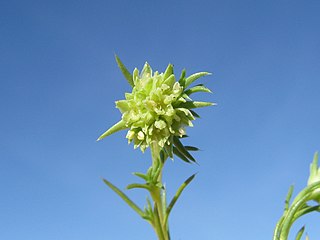
Scleranthus diander commonly known as tufted knawel, is a flowering plant in the family Caryophyllaceae, it grows in eastern states of Australia and the Australian Capital Territory. It is a small, spreading herb with white or light green flowers.
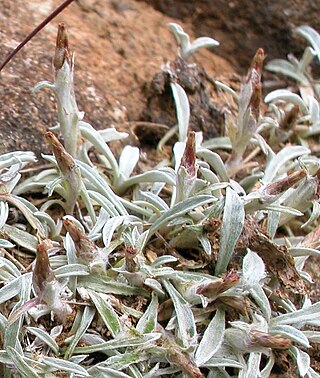
Euchiton traversii, commonly known as mat cudweed, is a small, woolly, alpine rosette herb. It forms a mat-like habit, hence the common name, in alpine wet heath and grasslands. The species is found in Australia—in Tasmania, Victoria, New South Wales, Australian Capital Territory—and the North and South Islands of New Zealand.
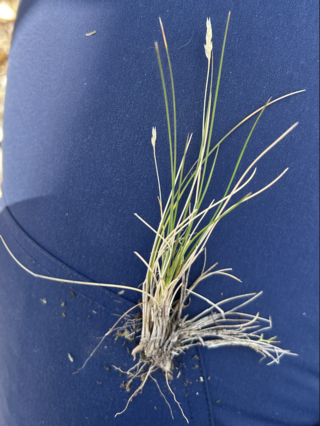
Poa clivicola, commonly known as fine-leaved snow grass, is an endangered Australian grass species, restricted to alpine grassy vegetation. Poa from the Greek poa (grass), clivicola- from the Latin clivus (hill) and -cola (dweller).

